Deck 1: An Introduction to the Human Body
Question
Question
Question
Question
Question
Question
Question
Question
Question
Question
Question
Question
Question
Question
Question
Question
Question
Question
Question
Question
Question
Question
Question
Question
Question
Question
Question
Question
Question
Question
Question
Question
Question
Question
Question
Question
Question
Question
Question
Question
Question
Question
Question
Question
Question
Question
Question
Question
Question
Question
Question
Question
Question
Question
Question
Question
Question
Question
Question
Question
Question
Question
Question
Question
Question
Question
Question
Question
Question
Question
Question
Question
Question
Question
Question
Question
Question
Question
Question
Question

Unlock Deck
Sign up to unlock the cards in this deck!
Unlock Deck
Unlock Deck
1/102
Play
Full screen (f)
Deck 1: An Introduction to the Human Body
1
The body is in the ___ position when laying face down.
A) sagittal
B) proximal
C) supine
D) prone
E) oblique
A) sagittal
B) proximal
C) supine
D) prone
E) oblique
D
2
The study of body structures and relationships among structures is called ___.
A) physiology
B) histology
C) embryology
D) biology
E) anatomy
A) physiology
B) histology
C) embryology
D) biology
E) anatomy
E
3
This component of a feedback system provides input directly to the control center.
A) effector
B) receptor
C) brain
D) stimulus
E) efferent
A) effector
B) receptor
C) brain
D) stimulus
E) efferent
B
4
When anatomists use directional terms, which of these is NOT a consideration?
A) The position of a body part is described relative to another body part.
B) Structures such as blood vessels can be described relative to an origin, the heart, using the terms proximal or distal.
C) Humans stand upright, so terms such as anterior and ventral (or posterior and dorsal, or superior and cephalic) are interchangeable; this is not true for four-legged animals.
D) Structures on the limbs are usually described as proximal or distal.
E) The directional terms are used with the assumption that the body is in a supine position with the hands facing palm upward.
A) The position of a body part is described relative to another body part.
B) Structures such as blood vessels can be described relative to an origin, the heart, using the terms proximal or distal.
C) Humans stand upright, so terms such as anterior and ventral (or posterior and dorsal, or superior and cephalic) are interchangeable; this is not true for four-legged animals.
D) Structures on the limbs are usually described as proximal or distal.
E) The directional terms are used with the assumption that the body is in a supine position with the hands facing palm upward.

Unlock Deck
Unlock for access to all 102 flashcards in this deck.
Unlock Deck
k this deck
5
Two organs on the same side of the body, such as the spleen and the descending colon, are ___.
A) distal
B) ipsilateral
C) proximal
D) contralateral
E) intermediate
A) distal
B) ipsilateral
C) proximal
D) contralateral
E) intermediate

Unlock Deck
Unlock for access to all 102 flashcards in this deck.
Unlock Deck
k this deck
6
Which of the following anatomical terms best describes the indicated region? 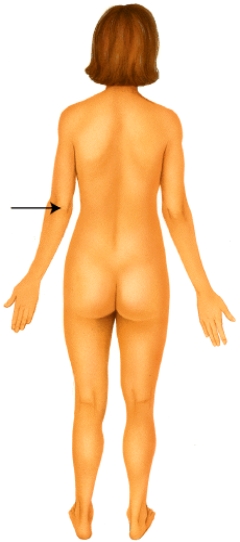
A) popliteal
B) mental
C) crural
D) olecranal
E) occipital

A) popliteal
B) mental
C) crural
D) olecranal
E) occipital

Unlock Deck
Unlock for access to all 102 flashcards in this deck.
Unlock Deck
k this deck
7
When an examiner feels the body surfaces with hands, for example to detect enlarged or tender organs, this is called ___.
A) inspection.
B) percussion.
C) auscultation.
D) palpation.
E) ultrasonography.
A) inspection.
B) percussion.
C) auscultation.
D) palpation.
E) ultrasonography.

Unlock Deck
Unlock for access to all 102 flashcards in this deck.
Unlock Deck
k this deck
8
Which of the following choices is NOT considered to be a basic life process?
A) reproduction
B) metabolism
C) growth
D) responsiveness
E) pathology
A) reproduction
B) metabolism
C) growth
D) responsiveness
E) pathology

Unlock Deck
Unlock for access to all 102 flashcards in this deck.
Unlock Deck
k this deck
9
The spleen, thymus, and tonsils are all organs that function within the ___.
A) urinary system
B) digestive system
C) endocrine system
D) lymphatic system
E) cardiovascular system
A) urinary system
B) digestive system
C) endocrine system
D) lymphatic system
E) cardiovascular system

Unlock Deck
Unlock for access to all 102 flashcards in this deck.
Unlock Deck
k this deck
10
A 24 year old female presents to the emergency room complaining of the following symptoms:
• Acute lower right quadrant abdominal pain rated at an 9 out of 10 on the pain scale (10 being the worst pain ever!), that she characterizes as "burning and stabbing" in quality
• Feelings of nausea, dizziness and weakness.
• No difficulty breathing
As her physician, you notice that she exhibits the following signs:
• A very high fever (104ºF)
• High blood pressure (146/90)
• A rapid heart rate (110 beats per minute)
• Clear lung sounds- although her respiratory rate is rapid.
Which of the following choices is the most likely the correct diagnosis?
A) hypoglycemia (low blood sugar)
B) pulmonary embolus (blood clot in the lungs)
C) acute appendicitis
D) meningitis
E) pneumonia
• Acute lower right quadrant abdominal pain rated at an 9 out of 10 on the pain scale (10 being the worst pain ever!), that she characterizes as "burning and stabbing" in quality
• Feelings of nausea, dizziness and weakness.
• No difficulty breathing
As her physician, you notice that she exhibits the following signs:
• A very high fever (104ºF)
• High blood pressure (146/90)
• A rapid heart rate (110 beats per minute)
• Clear lung sounds- although her respiratory rate is rapid.
Which of the following choices is the most likely the correct diagnosis?
A) hypoglycemia (low blood sugar)
B) pulmonary embolus (blood clot in the lungs)
C) acute appendicitis
D) meningitis
E) pneumonia

Unlock Deck
Unlock for access to all 102 flashcards in this deck.
Unlock Deck
k this deck
11
Along which of the following body planes has this section been made? 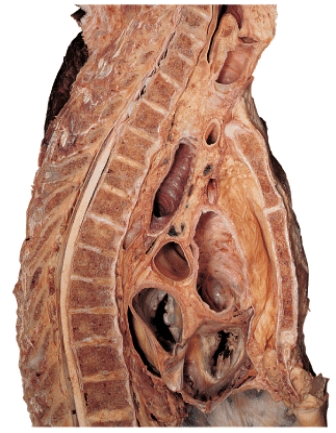
A) oblique
B) frontal
C) sagittal
D) coronal
E) transverse

A) oblique
B) frontal
C) sagittal
D) coronal
E) transverse

Unlock Deck
Unlock for access to all 102 flashcards in this deck.
Unlock Deck
k this deck
12
When the examiner uses a stethoscope to amplify the sound of breathing into the lungs, this is called ___.
A) inspection.
B) percussion.
C) auscultation.
D) palpation.
E) ultrasonography.
A) inspection.
B) percussion.
C) auscultation.
D) palpation.
E) ultrasonography.

Unlock Deck
Unlock for access to all 102 flashcards in this deck.
Unlock Deck
k this deck
13
The study of body function, how the body parts work, is called ___.
A) physiology
B) histology
C) embryology
D) biology
E) anatomy
A) physiology
B) histology
C) embryology
D) biology
E) anatomy

Unlock Deck
Unlock for access to all 102 flashcards in this deck.
Unlock Deck
k this deck
14
The heart is ___ to the lungs.
A) distal
B) proximal
C) ipsilateral
D) medial
E) contralateral
A) distal
B) proximal
C) ipsilateral
D) medial
E) contralateral

Unlock Deck
Unlock for access to all 102 flashcards in this deck.
Unlock Deck
k this deck
15
The body is in the ___ position when laying face up.
A) prone
B) proximal
C) supine
D) intermediate
E) oblique
A) prone
B) proximal
C) supine
D) intermediate
E) oblique

Unlock Deck
Unlock for access to all 102 flashcards in this deck.
Unlock Deck
k this deck
16
Two organs on the opposite side of the body, such as the spleen and the gallbladder, are ___.
A) distal
B) ipsilateral
C) proximal
D) contralateral
E) intermediate
A) distal
B) ipsilateral
C) proximal
D) contralateral
E) intermediate

Unlock Deck
Unlock for access to all 102 flashcards in this deck.
Unlock Deck
k this deck
17
This component of a feedback system receives output from the control center.
A) effector
B) stimulus
C) receptor
D) central Nervous System
E) afferent
A) effector
B) stimulus
C) receptor
D) central Nervous System
E) afferent

Unlock Deck
Unlock for access to all 102 flashcards in this deck.
Unlock Deck
k this deck
18
Which term best describes the view shown in this image of the human skull? 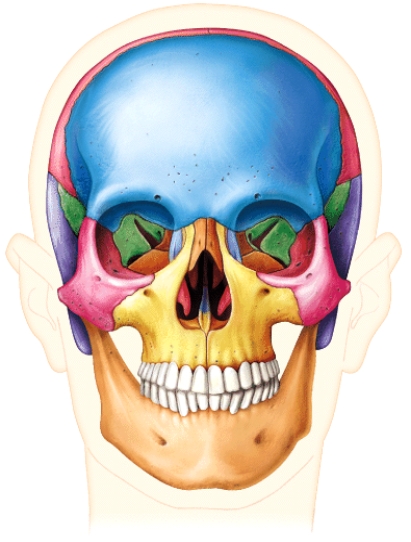
A) anterior
B) medial
C) posterior
D) ipsilateral
E) lateral

A) anterior
B) medial
C) posterior
D) ipsilateral
E) lateral

Unlock Deck
Unlock for access to all 102 flashcards in this deck.
Unlock Deck
k this deck
19
A good example of a positive feedback mechanism would be:
A) enhancement of labor contraction by oxytocin
B) blood calcium regulation
C) blood pressure regulation
D) blood glucose regulation
E) body temperature regulation
A) enhancement of labor contraction by oxytocin
B) blood calcium regulation
C) blood pressure regulation
D) blood glucose regulation
E) body temperature regulation

Unlock Deck
Unlock for access to all 102 flashcards in this deck.
Unlock Deck
k this deck
20
Which of the following statements best describes the location of the radius bone anatomically?
A) It is proximal to the carpal region and inferior to the manual region.
B) It is the lateral bone of the antebrachium.
C) It is located in the crural region.
D) It is inferior to the femoral region and superior to the tarsal region.
E) It is distal to the antecubital region, and is the medial bone of the crural region.
A) It is proximal to the carpal region and inferior to the manual region.
B) It is the lateral bone of the antebrachium.
C) It is located in the crural region.
D) It is inferior to the femoral region and superior to the tarsal region.
E) It is distal to the antecubital region, and is the medial bone of the crural region.

Unlock Deck
Unlock for access to all 102 flashcards in this deck.
Unlock Deck
k this deck
21
Which of these answers describes the sum of all chemical reactions that occur in the body?
A) metabolism
B) catalyst
C) anabolism
D) catabolism
E) homeostasis
A) metabolism
B) catalyst
C) anabolism
D) catabolism
E) homeostasis

Unlock Deck
Unlock for access to all 102 flashcards in this deck.
Unlock Deck
k this deck
22
The term sacral refers to the ___.
A) chin
B) area between the shoulder blades
C) area at the base of the skull
D) area inferior to the lumbar region and medial to the coxae
E) calf of the leg
A) chin
B) area between the shoulder blades
C) area at the base of the skull
D) area inferior to the lumbar region and medial to the coxae
E) calf of the leg

Unlock Deck
Unlock for access to all 102 flashcards in this deck.
Unlock Deck
k this deck
23
The mental region is ___ to the orbital region.
A) inferior
B) deep
C) superficial
D) lateral
E) contralateral
A) inferior
B) deep
C) superficial
D) lateral
E) contralateral

Unlock Deck
Unlock for access to all 102 flashcards in this deck.
Unlock Deck
k this deck
24
The pancreas is an organ that plays a role in the ___.
A) digestive and urinary systems
B) respiratory and digestive systems
C) endocrine and lymphatic systems
D) respiratory and lymphatic systems
E) endocrine and digestive systems
A) digestive and urinary systems
B) respiratory and digestive systems
C) endocrine and lymphatic systems
D) respiratory and lymphatic systems
E) endocrine and digestive systems

Unlock Deck
Unlock for access to all 102 flashcards in this deck.
Unlock Deck
k this deck
25
A group of cells with similar emergent functional properties is defined as a(n):
A) organism
B) compound
C) tissue
D) organ
E) molecule
A) organism
B) compound
C) tissue
D) organ
E) molecule

Unlock Deck
Unlock for access to all 102 flashcards in this deck.
Unlock Deck
k this deck
26
Which of the following anatomical terms best describes the indicated region? 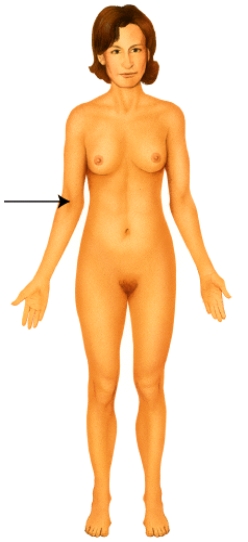
A) otic
B) popliteal
C) antecubital
D) olecranal
E) occipital

A) otic
B) popliteal
C) antecubital
D) olecranal
E) occipital

Unlock Deck
Unlock for access to all 102 flashcards in this deck.
Unlock Deck
k this deck
27
Which of these are the smallest living units of an organism?
A) molecules
B) cells
C) tissues
D) protons
E) organs
A) molecules
B) cells
C) tissues
D) protons
E) organs

Unlock Deck
Unlock for access to all 102 flashcards in this deck.
Unlock Deck
k this deck
28
Which one of the following terms describes the body's ability to detect and respond to changes in the internal or external environment?
A) responsiveness
B) reproduction
C) differentiation
D) metabolism
E) catabolism
A) responsiveness
B) reproduction
C) differentiation
D) metabolism
E) catabolism

Unlock Deck
Unlock for access to all 102 flashcards in this deck.
Unlock Deck
k this deck
29
Which of the following anatomical terms best describes the indicated region? 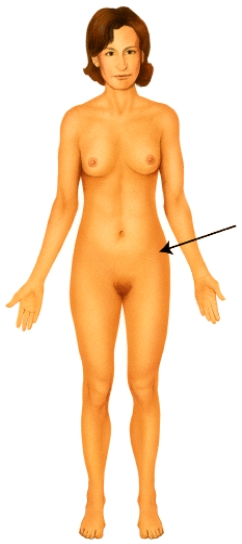
A) mental
B) popliteal
C) antecubital
D) olecranal
E) coxal

A) mental
B) popliteal
C) antecubital
D) olecranal
E) coxal

Unlock Deck
Unlock for access to all 102 flashcards in this deck.
Unlock Deck
k this deck
30
The organs in the human body ___.
A) function entirely independently from one another
B) are made of a single tissue type
C) are the smallest living units in the human body
D) include examples such as the bones, the skin, the heart and the lungs
E) can only contribute to the function of a single organ system, such as the gonads contributing to the function of the reproductive system
A) function entirely independently from one another
B) are made of a single tissue type
C) are the smallest living units in the human body
D) include examples such as the bones, the skin, the heart and the lungs
E) can only contribute to the function of a single organ system, such as the gonads contributing to the function of the reproductive system

Unlock Deck
Unlock for access to all 102 flashcards in this deck.
Unlock Deck
k this deck
31
Which of the following statements is TRUE?
A) The cranial cavity houses the brain and is lined by the pleural membranes.
B) The pericardial cavity lies within the superior portion of the mediastinum.
C) The pleural cavities are lined by a membrane called the parietal peritoneum.
D) The visceral layer of a serous membrane covers the organ it protects.
E) The superior border of the pelvic cavity is the diaphragm.
A) The cranial cavity houses the brain and is lined by the pleural membranes.
B) The pericardial cavity lies within the superior portion of the mediastinum.
C) The pleural cavities are lined by a membrane called the parietal peritoneum.
D) The visceral layer of a serous membrane covers the organ it protects.
E) The superior border of the pelvic cavity is the diaphragm.

Unlock Deck
Unlock for access to all 102 flashcards in this deck.
Unlock Deck
k this deck
32
The term brachial refers to the ___.
A) chin
B) fingers
C) arm
D) forearm
E) top of the head
A) chin
B) fingers
C) arm
D) forearm
E) top of the head

Unlock Deck
Unlock for access to all 102 flashcards in this deck.
Unlock Deck
k this deck
33
The carpal region is ___ to the antebrachium.
A) proximal
B) superior
C) deep
D) distal
E) medial
A) proximal
B) superior
C) deep
D) distal
E) medial

Unlock Deck
Unlock for access to all 102 flashcards in this deck.
Unlock Deck
k this deck
34
Which of the following organs would NOT be visible if the body was sectioned along a mid-sagittal plane?
A) heart
B) adrenal gland
C) small intestine
D) liver
E) uterus
A) heart
B) adrenal gland
C) small intestine
D) liver
E) uterus

Unlock Deck
Unlock for access to all 102 flashcards in this deck.
Unlock Deck
k this deck
35
The term otic refers to the:
A) eye
B) leg
C) shoulder
D) ear
E) elbow
A) eye
B) leg
C) shoulder
D) ear
E) elbow

Unlock Deck
Unlock for access to all 102 flashcards in this deck.
Unlock Deck
k this deck
36
The term sural refers to the ___.
A) skin
B) ear
C) forehead
D) shoulder
E) calf
A) skin
B) ear
C) forehead
D) shoulder
E) calf

Unlock Deck
Unlock for access to all 102 flashcards in this deck.
Unlock Deck
k this deck
37
Which of the following terms best describes the location of the stomach relative to the pancreas?
A) deep
B) serous
C) distal
D) transverse
E) anterior
A) deep
B) serous
C) distal
D) transverse
E) anterior

Unlock Deck
Unlock for access to all 102 flashcards in this deck.
Unlock Deck
k this deck
38
Which of the following is a TRUE statement concerning the selected feedback mechanism in a healthy individual?
A) Positive feedback mechanisms are stable, and the most common means to maintain homeostasis in the body.
B) Blood glucose levels are regulated by positive feedback mechanisms.
C) Elevated blood sugar levels (hyperglycemia) result in the release of glucagon from the pancreas, which stimulates the breakdown of glycogen into glucose-resulting in more glucose in the bloodstream.
D) Blood pressure regulation is a good example of positive feedback, because the response to the initial stimulus increases the stimulus.
E) Stretch receptors in the cervix, stimulated by the fetus during labor and delivery, result in the release of a hormone that stimulates more forceful uterine contractions and additional "stretch" or dilation of the cervix. This is a good example of a positive feedback mechanism.
A) Positive feedback mechanisms are stable, and the most common means to maintain homeostasis in the body.
B) Blood glucose levels are regulated by positive feedback mechanisms.
C) Elevated blood sugar levels (hyperglycemia) result in the release of glucagon from the pancreas, which stimulates the breakdown of glycogen into glucose-resulting in more glucose in the bloodstream.
D) Blood pressure regulation is a good example of positive feedback, because the response to the initial stimulus increases the stimulus.
E) Stretch receptors in the cervix, stimulated by the fetus during labor and delivery, result in the release of a hormone that stimulates more forceful uterine contractions and additional "stretch" or dilation of the cervix. This is a good example of a positive feedback mechanism.

Unlock Deck
Unlock for access to all 102 flashcards in this deck.
Unlock Deck
k this deck
39
The pancreas and liver are organs in the ___ system.
A) integumentary
B) lymphatic
C) digestive
D) reproductive
E) skeletal
A) integumentary
B) lymphatic
C) digestive
D) reproductive
E) skeletal

Unlock Deck
Unlock for access to all 102 flashcards in this deck.
Unlock Deck
k this deck
40
The thoracic region is ___ to the inguinal region.
A) superior
B) deep
C) distal
D) ipsilateral
E) supine
A) superior
B) deep
C) distal
D) ipsilateral
E) supine

Unlock Deck
Unlock for access to all 102 flashcards in this deck.
Unlock Deck
k this deck
41
What is the name of this region? 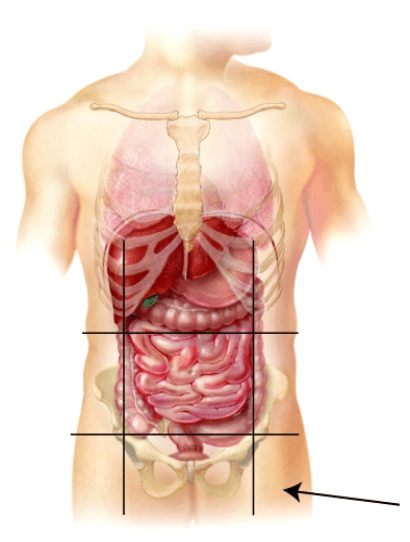
A) left hypochondriac
B) right Lumbar
C) left inguinal
D) hypogastric
E) mental

A) left hypochondriac
B) right Lumbar
C) left inguinal
D) hypogastric
E) mental

Unlock Deck
Unlock for access to all 102 flashcards in this deck.
Unlock Deck
k this deck
42
An individual has been in a traumatic motor vehicle accident and has been ejected from the vehicle because they were not wearing their seatbelt. The person is conscious, and complaining of left upper quadrant pain. When you visualize the area, it has significant swelling and is painful to palpation. Which one of the following organs is located in that area and might be of concern?
A) appendix
B) urinary bladder
C) brain
D) spleen
E) gall bladder
A) appendix
B) urinary bladder
C) brain
D) spleen
E) gall bladder

Unlock Deck
Unlock for access to all 102 flashcards in this deck.
Unlock Deck
k this deck
43
Which of the following is NOT retroperitoneal?
A) pancreas
B) adrenal gland
C) stomach
D) duodenum of small intestine
E) kidney
A) pancreas
B) adrenal gland
C) stomach
D) duodenum of small intestine
E) kidney

Unlock Deck
Unlock for access to all 102 flashcards in this deck.
Unlock Deck
k this deck
44
Which of these is the function of serous fluid?
A) protect the central nervous system
B) separate the abdominal and pelvic cavities
C) reduce friction between organs
D) circulate respiratory gases
E) carry nervous impulses
A) protect the central nervous system
B) separate the abdominal and pelvic cavities
C) reduce friction between organs
D) circulate respiratory gases
E) carry nervous impulses

Unlock Deck
Unlock for access to all 102 flashcards in this deck.
Unlock Deck
k this deck
45
An individual has been in a traumatic motor vehicle accident and has been ejected from the vehicle because they were not wearing their seatbelt. The person is unconscious, has no pulse, and is apneic (not breathing). You notice some clear fluid leaking from the otic region. You also see some significant lacerations in the cranial region, and the bleeding is profuse. Where is the leakage of clear fluid located?
A) ear
B) base of the skull
C) eye
D) nose
E) mouth
A) ear
B) base of the skull
C) eye
D) nose
E) mouth

Unlock Deck
Unlock for access to all 102 flashcards in this deck.
Unlock Deck
k this deck
46
In which cavity is the spleen located?
A) cranial cavity
B) mediastinal cavity
C) pleural cavity
D) pelvic cavity
E) abdominal cavity
A) cranial cavity
B) mediastinal cavity
C) pleural cavity
D) pelvic cavity
E) abdominal cavity

Unlock Deck
Unlock for access to all 102 flashcards in this deck.
Unlock Deck
k this deck
47
The sternum is ___ to the heart.
A) deep
B) anterior
C) inferior
D) distal
E) transverse
A) deep
B) anterior
C) inferior
D) distal
E) transverse

Unlock Deck
Unlock for access to all 102 flashcards in this deck.
Unlock Deck
k this deck
48
Which of these answers is defined as the process of breaking down larger substances into simpler ones?
A) metabolism
B) anabolism
C) catabolism
D) auscultation
E) palpation
A) metabolism
B) anabolism
C) catabolism
D) auscultation
E) palpation

Unlock Deck
Unlock for access to all 102 flashcards in this deck.
Unlock Deck
k this deck
49
In which cavity is the brain located?
A) cranial cavity
B) mediastinal cavity
C) pleural cavity
D) pelvic cavity
E) vertebral cavity
A) cranial cavity
B) mediastinal cavity
C) pleural cavity
D) pelvic cavity
E) vertebral cavity

Unlock Deck
Unlock for access to all 102 flashcards in this deck.
Unlock Deck
k this deck
50
A transverse plane will section a body or organ into ___.
A) anterior and posterior
B) left and right
C) superior and inferior
D) unequal left and right sides
E) proximal and distal
A) anterior and posterior
B) left and right
C) superior and inferior
D) unequal left and right sides
E) proximal and distal

Unlock Deck
Unlock for access to all 102 flashcards in this deck.
Unlock Deck
k this deck
51
This plane divides the body into anterior and posterior portions.
A) oblique
B) frontal
C) horizontal
D) transverse
E) midsagittal
A) oblique
B) frontal
C) horizontal
D) transverse
E) midsagittal

Unlock Deck
Unlock for access to all 102 flashcards in this deck.
Unlock Deck
k this deck
52
Which term describes the serous membrane lining the cavity that houses the lungs?
A) parietal pericardium
B) parietal peritoneum
C) visceral peritoneum
D) parietal pleura
E) visceral pleura
A) parietal pericardium
B) parietal peritoneum
C) visceral peritoneum
D) parietal pleura
E) visceral pleura

Unlock Deck
Unlock for access to all 102 flashcards in this deck.
Unlock Deck
k this deck
53
A female is having pain in her hypogastric region. Which organ is NOT located in this region?
A) uterus
B) spleen
C) urinary bladder
D) large intestines
E) small intestines
A) uterus
B) spleen
C) urinary bladder
D) large intestines
E) small intestines

Unlock Deck
Unlock for access to all 102 flashcards in this deck.
Unlock Deck
k this deck
54
This is the skill and science of distinguishing one disorder or disease from another.
A) anatomy
B) physiology
C) dissection
D) diagnosis
E) immunology
A) anatomy
B) physiology
C) dissection
D) diagnosis
E) immunology

Unlock Deck
Unlock for access to all 102 flashcards in this deck.
Unlock Deck
k this deck
55
Which of these is defined as a group of cells with similar structure and function?
A) tissue
B) organ
C) molecules
D) compounds
E) organism
A) tissue
B) organ
C) molecules
D) compounds
E) organism

Unlock Deck
Unlock for access to all 102 flashcards in this deck.
Unlock Deck
k this deck
56
Which of these answers is the best example of a retroperitoneal organ?
A) pancreas
B) liver
C) heart
D) stomach
E) jejunum of small intestine
A) pancreas
B) liver
C) heart
D) stomach
E) jejunum of small intestine

Unlock Deck
Unlock for access to all 102 flashcards in this deck.
Unlock Deck
k this deck
57
This is a change in body function that can be measured objectively.
A) symptom
B) disorder
C) disease
D) X-ray
E) sign
A) symptom
B) disorder
C) disease
D) X-ray
E) sign

Unlock Deck
Unlock for access to all 102 flashcards in this deck.
Unlock Deck
k this deck
58
Which cavity would enclose the heart?
A) cranial cavity
B) pericardial cavity
C) vertebral cavity
D) abdominal cavity
E) pleural cavity
A) cranial cavity
B) pericardial cavity
C) vertebral cavity
D) abdominal cavity
E) pleural cavity

Unlock Deck
Unlock for access to all 102 flashcards in this deck.
Unlock Deck
k this deck
59
Which term describes the serous membrane lining the cavity that houses the liver?
A) parietal pericardium
B) parietal peritoneum
C) dura mater
D) parietal pleura
E) parietal mediastinum
A) parietal pericardium
B) parietal peritoneum
C) dura mater
D) parietal pleura
E) parietal mediastinum

Unlock Deck
Unlock for access to all 102 flashcards in this deck.
Unlock Deck
k this deck
60
Which of the following statements best defines a disorder?
A) an illness accompanied by signs and symptoms
B) subjective changes experienced by the patient
C) an abnormality of structure or function
D) measurable changes that can be observed clinically
E) both subjective changes experienced by the patient and measurable changes that can be observed clinically.
A) an illness accompanied by signs and symptoms
B) subjective changes experienced by the patient
C) an abnormality of structure or function
D) measurable changes that can be observed clinically
E) both subjective changes experienced by the patient and measurable changes that can be observed clinically.

Unlock Deck
Unlock for access to all 102 flashcards in this deck.
Unlock Deck
k this deck
61
Which cavity would include a lung?
A) cranial cavity
B) vertebral cavity
C) abdominal cavity
D) pericardial cavity
E) pleural cavity
A) cranial cavity
B) vertebral cavity
C) abdominal cavity
D) pericardial cavity
E) pleural cavity

Unlock Deck
Unlock for access to all 102 flashcards in this deck.
Unlock Deck
k this deck
62
The heart is ___ to the liver.
A) inferior
B) anterior
C) contralateral
D) superior
E) superficial
A) inferior
B) anterior
C) contralateral
D) superior
E) superficial

Unlock Deck
Unlock for access to all 102 flashcards in this deck.
Unlock Deck
k this deck
63
Which of these body fluids most directly affects the proper functioning of cells?
A) lymph
B) blood
C) interstitial fluid
D) aqueous humor
E) vitreous body
A) lymph
B) blood
C) interstitial fluid
D) aqueous humor
E) vitreous body

Unlock Deck
Unlock for access to all 102 flashcards in this deck.
Unlock Deck
k this deck
64
In which cavity is the stomach located?
A) cranial cavity
B) vertebral cavity
C) abdominal cavity
D) pericardial cavity
E) pleural cavity
A) cranial cavity
B) vertebral cavity
C) abdominal cavity
D) pericardial cavity
E) pleural cavity

Unlock Deck
Unlock for access to all 102 flashcards in this deck.
Unlock Deck
k this deck
65
In which cavity are the lungs located?
A) cranial cavity
B) vertebral cavity
C) abdominal cavity
D) pericardial cavity
E) pleural cavity
A) cranial cavity
B) vertebral cavity
C) abdominal cavity
D) pericardial cavity
E) pleural cavity

Unlock Deck
Unlock for access to all 102 flashcards in this deck.
Unlock Deck
k this deck
66
An oblique plane will cut a body or organ into ___.
A) anterior and posterior
B) left and right
C) superior and inferior
D) sections along an angle
E) unequal left and right sides
A) anterior and posterior
B) left and right
C) superior and inferior
D) sections along an angle
E) unequal left and right sides

Unlock Deck
Unlock for access to all 102 flashcards in this deck.
Unlock Deck
k this deck
67
Which of the following organs is NOT found in the abdominal cavity?
A) stomach
B) spleen
C) liver
D) gallbladder
E) diaphragm
A) stomach
B) spleen
C) liver
D) gallbladder
E) diaphragm

Unlock Deck
Unlock for access to all 102 flashcards in this deck.
Unlock Deck
k this deck
68
A condition that is NOT regulated by a negative feedback loop would be ___.
A) childbirth
B) body temperature
C) blood pressure
D) heart rate
E) blood sugar levels
A) childbirth
B) body temperature
C) blood pressure
D) heart rate
E) blood sugar levels

Unlock Deck
Unlock for access to all 102 flashcards in this deck.
Unlock Deck
k this deck
69
Where on the diagram is the femoral area? 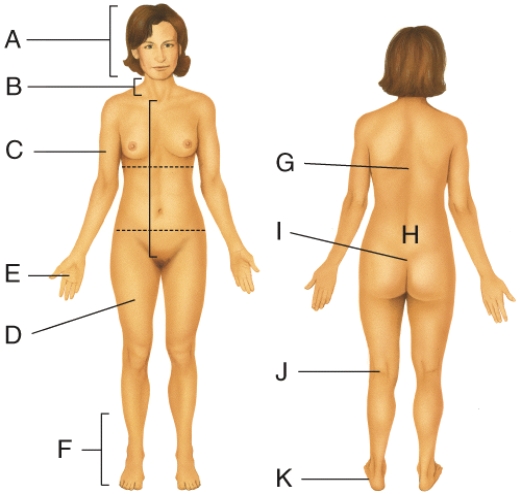
A) D
B) E
C) F
D) J
E) K

A) D
B) E
C) F
D) J
E) K

Unlock Deck
Unlock for access to all 102 flashcards in this deck.
Unlock Deck
k this deck
70
This covers the viscera within the thoracic and abdominal cavities and lines the walls of the thorax and abdomen.
A) pericardium
B) pleura
C) mediastinum
D) diaphragm
E) serous membrane
A) pericardium
B) pleura
C) mediastinum
D) diaphragm
E) serous membrane

Unlock Deck
Unlock for access to all 102 flashcards in this deck.
Unlock Deck
k this deck
71
This directional term is the opposite of deep.
A) superficial
B) superior
C) inferior
D) distal
E) proximal
A) superficial
B) superior
C) inferior
D) distal
E) proximal

Unlock Deck
Unlock for access to all 102 flashcards in this deck.
Unlock Deck
k this deck
72
Which of these directional terms means farthest from the midline?
A) medial B) anterior
C) proximal
D) deep
E) lateral
A) medial B) anterior
C) proximal
D) deep
E) lateral

Unlock Deck
Unlock for access to all 102 flashcards in this deck.
Unlock Deck
k this deck
73
This is a change in body function that is subjective and is described by the patient to the clinician.
A) symptom B) disorder
C) disturbance
D) disease
E) sign
A) symptom B) disorder
C) disturbance
D) disease
E) sign

Unlock Deck
Unlock for access to all 102 flashcards in this deck.
Unlock Deck
k this deck
74
Which of these answers is defined as the regulation of body conditions within normal limits?
A) palpation
B) percussion
C) homeostasis
D) autopsy
E) histology
A) palpation
B) percussion
C) homeostasis
D) autopsy
E) histology

Unlock Deck
Unlock for access to all 102 flashcards in this deck.
Unlock Deck
k this deck
75
Membranes that cover lung tissue are called ___.
A) meninges
B) visceral pleura
C) parietal mesenteries
D) parietal serosa
E) dura mater
A) meninges
B) visceral pleura
C) parietal mesenteries
D) parietal serosa
E) dura mater

Unlock Deck
Unlock for access to all 102 flashcards in this deck.
Unlock Deck
k this deck
76
This is the structure of a feedback system that receives output from the control center.
A) receptor B) body fluids
C) brain
D) effector
E) afferent
A) receptor B) body fluids
C) brain
D) effector
E) afferent

Unlock Deck
Unlock for access to all 102 flashcards in this deck.
Unlock Deck
k this deck
77
This cavity is inferior to the abdominal cavity.
A) vertebral cavity
B) cranial cavity
C) abdominal cavity
D) pericardial cavity
E) pelvic cavity
A) vertebral cavity
B) cranial cavity
C) abdominal cavity
D) pericardial cavity
E) pelvic cavity

Unlock Deck
Unlock for access to all 102 flashcards in this deck.
Unlock Deck
k this deck
78
This plane divides the body into unequal left and right sides.
A) frontal
B) midsagittal
C) transverse
D) oblique
E) parasagittal
A) frontal
B) midsagittal
C) transverse
D) oblique
E) parasagittal

Unlock Deck
Unlock for access to all 102 flashcards in this deck.
Unlock Deck
k this deck
79
Which of these directional terms means farther from the attachment of a limb to the trunk or farther from the origination of a structure?
A) deep
B) contralateral
C) lateral
D) cephalic
E) distal
A) deep
B) contralateral
C) lateral
D) cephalic
E) distal

Unlock Deck
Unlock for access to all 102 flashcards in this deck.
Unlock Deck
k this deck
80
Where on the diagram is the sacral area? 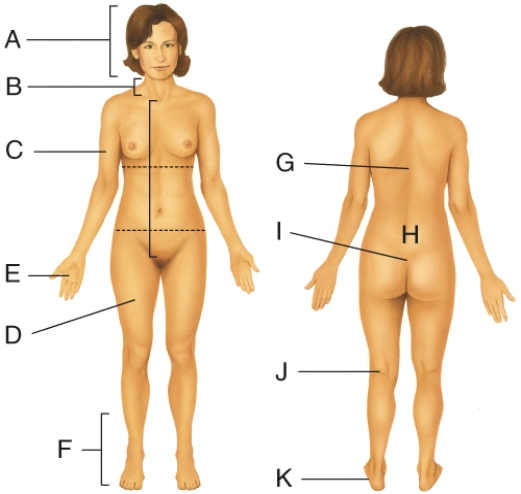
A) C
B) D
C) E
D) I
E) J

A) C
B) D
C) E
D) I
E) J

Unlock Deck
Unlock for access to all 102 flashcards in this deck.
Unlock Deck
k this deck



